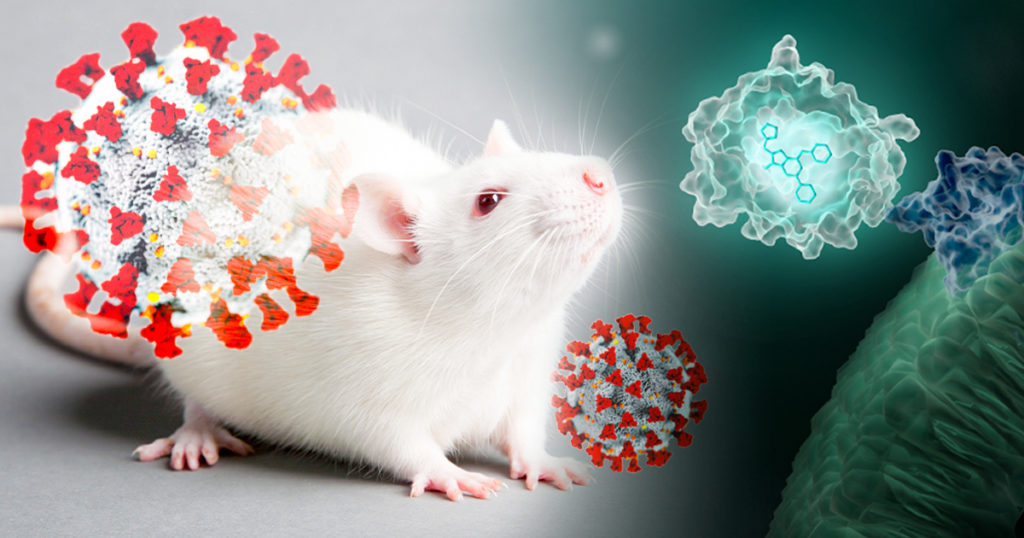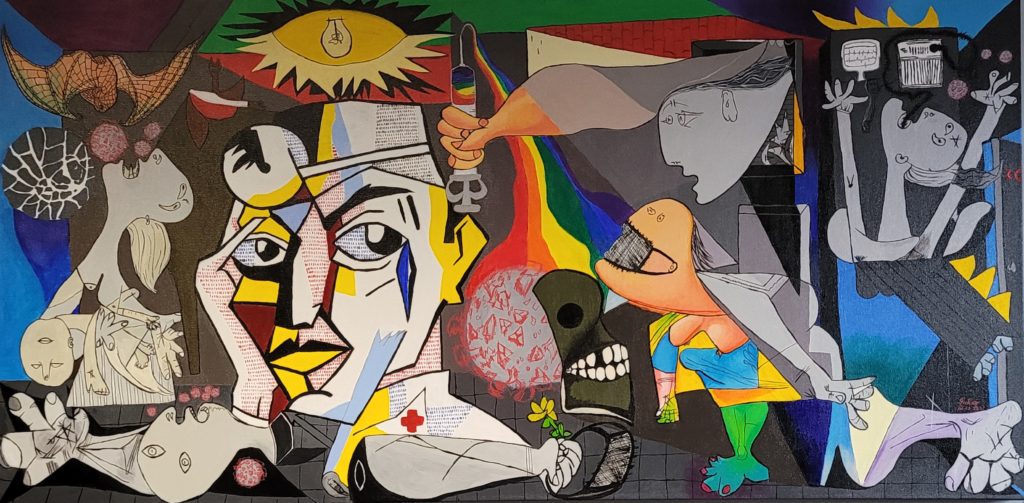
Wearing blue surgical gowns and white respirator hoods, research scientist Pradeep Uchil and post-doctoral fellow Irfan Ullah carry an anesthetized mouse to the lab’s imaging unit. Two days ago, the mouse was infected with a SARS-CoV-2 virus engineered to produce a bioluminescent protein. After an injection of a bioluminescence substrate, a blue glow starts to emanate from within the mouse’s nasal cavity and chest, visible to the imaging unit’s camera and Uchil’s eyes.
“We were never able to see this kind of signal with retrovirus infections.” Uchil is a research scientist at the Yale School of Medicine whose work focuses on the in vivo imaging of retroviral infections. Normally, the mouse would have to be sacrificed and “opened up” for viral bioluminescent signals from internal tissues to be imaged directly.
SARS-CoV-2 replicates vigorously, however, and enough bioluminescent reporter protein was produced to be visible through the mouse’s body for viral in vivo imaging. With no dissection required, Uchil and team could take images of the same mouse day after day, watching the blue glow spread beyond the mouse’s lungs. By day six, the glow reached the brain, and the mouse died.
Recently published in Immunity, this study describes the first bioluminescent platform for studying a respiratory pathogen requiring biosafety level 3 precautions, in this case, the SARS-CoV-2 virus. By being able to track the entire progression of SARS-CoV-2 infection in a living animal model, the research team was also able to “watch” how various treatments, specifically neutralizing antibody therapies, curbed the infection.
Two key technologies enabled this viral in vivo imaging work: a small and stable bioluminescent reporter and BSL-3 labs equipped for imaging reporter signals.
“Viruses are notorious for throwing out reporters that you try to insert,” said Uchil. RNA viruses “don’t want to keep exogenous genes in their genome because they’re already running a very tight ship.”
But the reporter gene for NanoLuc® Luciferase was small enough to be maintained in the SARS-CoV-2 genome for multiple rounds of virus replication.
“NLuc changed the game for us because it was so tiny,” said Uchil.
Making a virus light up is only part of the challenge. Having instruments for measuring that bioluminescence that are also housed in a lab rated for those pathogens is a rare capability. For the authors of this study, this specialized lab space arose from a long-standing collaboration between the Walther Mothes lab where Uchil works and colleagues at Yale.
“We couldn’t dream of doing research like this unless we had this level of instrumentation,” said Priti Kumar. “That’s something we accomplished at Yale through teamwork.” Kumar is one of the lead authors of the SARS-CoV-2 bioluminescence study and Associate Professor of Internal Medicine, Infectious Diseases and of Microbial Pathogenesis at the Yale School of Medicine.
Working under BSL-3 conditions “requires a very high level of technical skill, diligence and discipline. It’s important to understand the complexity of the work at hand and all the people contributing to this,” Kumar said.
As a leading expert in HIV pathogenesis in humanized mouse models, Kumar’s research focuses on developing treatments for diseases caused by RNA viruses. A long-standing collaboration with viral in vivo imaging experts like Uchil and Mothes led to the infrastructure and knowledge needed for a quick pivot to this SARS-CoV-2 research.
One of the foundational studies for the SARS-CoV-2 bioluminescence study involved a similar approach to studying HIV-1, the virus responsible for HIV infections in humans. In 2019, Kumar, Uchil and Mothes, along with collaborators, reported a study where they engineered an HIV-1 virus to carry a NanoLuc® Luciferease reporter. They used the engineered virus to visualize HIV infection in humanized mice receiving antiretroviral therapy – the current standard of care for patients with HIV.
“Being able to pinpoint where the virus hides transforms a shot in the dark to a precision strike.”
Priti Kumar
Developing reporter-expressing HIV-1 that was still infectious had been a real challenge due to the inability of the virus genome to accommodate foreign genes in its make-up. For the team, NanoLuc® Luciferease was transformative: NLuc reporter HIV-1 could infect and cause pathogenic effects in mice similar to human infections and the bioluminescence could be measured over days to months in living mouse models.
Where SARS-CoV-2 infection resembles a calvary charge against the host, HIV-1 works more like a sleeper agent, infiltrating the host and waiting to strike at a strategic time: existing therapies for HIV can halt replication of HIV-1 in hosts, but when those treatments are halted, replication rebounds and symptoms reemerge.
“You can never get rid of the virus. It becomes genetic material in the cells it infects,” said Kumar. “The key issue is you can never distinguish which cells are infected within the body. There are no biomarkers to distinguish these latently infected cells from others.”
In the 2019 study, the team was able to use NLuc reporter HIV-1 to visualize this cycle of infection, latency and rebound in humanized mouse models and to identify which tissues the rebound occurred within. Kumar believes that knowing where HIV-1 rebounds can open the door for therapies targeted to those sites.
“Being able to pinpoint where the virus hides transforms a shot in the dark to a precision strike, a completely new perspective,” Kumar said.
“Seeing is believing,” said Uchil.
As Kumar and Uchil’s teams continue their work with viral in vivo imaging and studying viral infections, one of their goals is to incorporate complementary bioluminescent reporters in other cell types so that they can follow other cellular processes simultaneously with viral infection and replication.
“The next frontier where the whole field is going to move is to monitor even the immune response in addition to virus replication,” Uchil said.
Underpinning Uchil and Kumar’s work is the hope that their studies will lead to therapies for viral diseases. The suffering brought on by COVID-19 pandemic sharpened those goals.
“This felt like the first moment in our life where, if we do something with our expertise gained by working with HIV and other retroviruses, we could actually see an application of our work in our own lifetime,” said Uchil.

Outside the lab, Kumar has also used her artistic skills to process the experience of living and working during a pandemic. In a painting that incorporates twisted forms inspired by Picasso’s Guernica and the medical face of Lichtenstein’s Dr. Waldman, Kumar captures the distress and grief of the past 18 months. But amid the painful imagery, Kumar also painted a hopeful vision:
An angel carrying a rainbow-colored vaccine.

